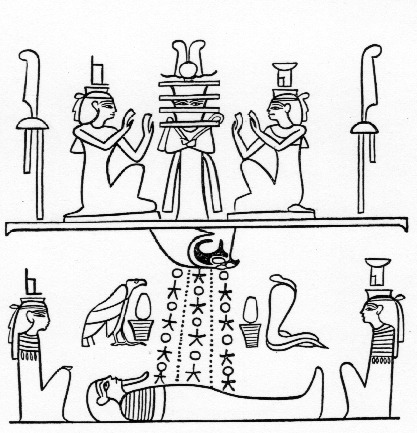Die "Herrin der Unterwelt"
Dec. 2nd, 2023 01:31 pmI stumbled through this German-language article with the help of Google translate, which was very gentle about the umlauts. It's about Hepet-Hor, but refers to her by one of the other epithets she's given, "Mistress of the Duat".
The goddess has various headdresses -- a cobra, an atef crown, a feather. In one example, she's given the name Neith; in another, Selkis; in still another Saryt. Refai suggests this could be explained by "special devotion or local ties". Hepet-Hor also appears as one of the gods in the Litany of Re.
Here's Google Translate's attempt at a key passage: "The exact nature and function of this underworld goddess remain difficult to interpret. In the variation of her representations, she shows several arbitrary combinations, which include protection symbols (knives, lions) on the one hand and symbols of regeneration (snakes, crocodiles) on the other. As is often the case, it combines protection and regeneration, the two most important afterlife hopes of the deceased." Her "embracing" is protective. IIUC, in a couple of papyri, Hepet-Hor's function is clear: she welcomes the deceased to the underworld. In some inscriptions she offers bread, beer, and "all good things" to the deceased, which reinforces this idea. Refai states that "The goddess certainly forms a partial aspect of the personified underworld kingdom from which the deceased hopes for reception, protection and regeneration."
__
Refai, Hosam. Die "Herrin der Unterwelt". in Ursula Rössler-Köhler et al (eds). Die Ihr Vorbeigehen Werdet. Berlin, New York, Walter de Gruyter, 2009.
With this and other epithets, a curious female figure appears on papyri and coffins of the Late Period, who apparently has an important, yet difficult to interpret, underworldly function. Her depiction remains unchanged, apart from variations in the shape of her head and the inscription. She is shown standing wearing a tight, long robe and holding a knife in both hands. There is often a sacrificial table in front of her, and in some examples Thoth presents her with a Western symbol.
Although Hepet-Hor's head and title/name change, she always wears one of those sheer dresses and has a knife in either hand. (I wonder if this helps to differentiate her from similar double-headed goddesses who don't have the knives - eg Niwinski fig. 25) She most often has the head of a snake, and most often appears in front of the double staircase / primordial mound / step pyramid thing, borne on the back of the great serpent, where Osiris is enthroned. She also sometimes appears at the judgement.The goddess has various headdresses -- a cobra, an atef crown, a feather. In one example, she's given the name Neith; in another, Selkis; in still another Saryt. Refai suggests this could be explained by "special devotion or local ties". Hepet-Hor also appears as one of the gods in the Litany of Re.
Here's Google Translate's attempt at a key passage: "The exact nature and function of this underworld goddess remain difficult to interpret. In the variation of her representations, she shows several arbitrary combinations, which include protection symbols (knives, lions) on the one hand and symbols of regeneration (snakes, crocodiles) on the other. As is often the case, it combines protection and regeneration, the two most important afterlife hopes of the deceased." Her "embracing" is protective. IIUC, in a couple of papyri, Hepet-Hor's function is clear: she welcomes the deceased to the underworld. In some inscriptions she offers bread, beer, and "all good things" to the deceased, which reinforces this idea. Refai states that "The goddess certainly forms a partial aspect of the personified underworld kingdom from which the deceased hopes for reception, protection and regeneration."
__
Refai, Hosam. Die "Herrin der Unterwelt". in Ursula Rössler-Köhler et al (eds). Die Ihr Vorbeigehen Werdet. Berlin, New York, Walter de Gruyter, 2009.
